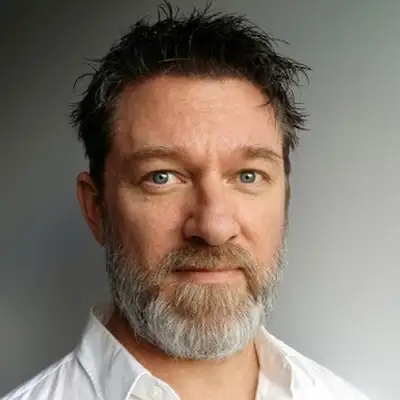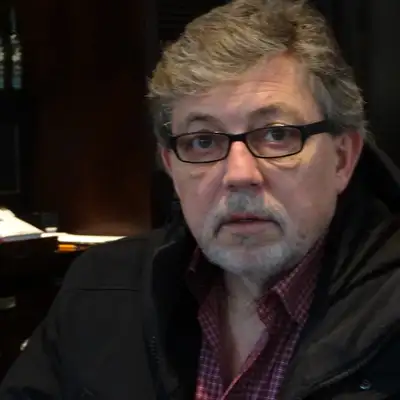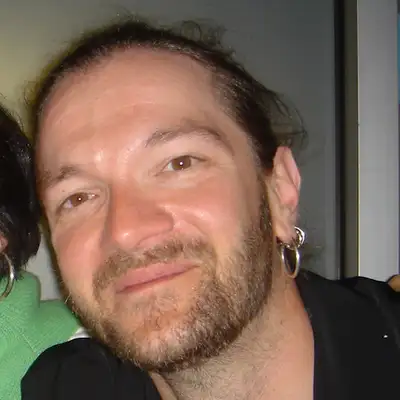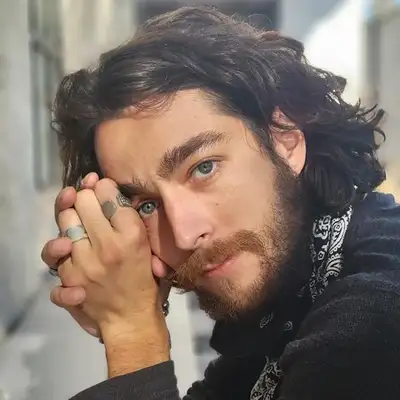Important Update: The website thecrystalcavemurders.com has been replaced by swissmurdermysteries.com
Click HERE to leave a rating or comment or here to FOLLOW
- Rudolph Isler
Creators and Guests
What is Swiss Murder Mysteries?
Uncover Switzerland’s most enigmatic murder cases with our riveting investigative true crime podcast.
In the previous episodes, we discussed the disappearance and subsequent discovery of the bodies, as well as the police investigations that led to the interrogation of 4 suspects. The previously convicted sex offender and 3 cave guides. Despite their extensive interrogations, none of the 4 could be linked to the double murder at the Crystal Caves, and none of them was ever arrested. However, to everyone's surprise, the police then presented a new and highly promising lead. They had found a used stocking near the body of Karen Gatiker in the half cave, which they believed belonged to the murderer.
Narrator:Furthermore, they were convinced that this item was used to kill at least 1 of the 2 girls and that it held the key to solving the case. Were they successful? Tune in to this episode to find out. My name is Rudolf Eisler, and this is The Case File XY, episode 5 of The Crystal Cave Murders, an investigative true crime podcast produced by Playground Media Productions. All interviews were recorded in German and translated into to English.
Narrator:All voiceovers were done by speakers that are not related to the case. All individuals mentioned in this podcast must be considered innocent and cannot be prosecuted or convicted, as the 30 year statute of limitation for murder in Switzerland was reached in 2012. The presumption of innocence applies. Convinced that they had found the murder weapon, the police decided to approach the popular interactive television series known as Achtenseigen ix Upsilon und Geluest, or Casefilexyunsolved in English. This groundbreaking program first aired in 1967 and quickly gained immense popularity aiming to combat and solve crimes by engaging with the growing television audience.
Narrator:It served as a potent alternative to print media, reaching a much wider audience across all German speaking countries. Its remarkable success led to its adaptation as Crimewatch UK by the BBC in 1984 and its introduction to the US market as America's Most Wanted in 1988. Meanwhile, numerous other countries including Ireland, Israel, Italy, the Netherlands, New Zealand, Australia, Poland, and Sweden have aired adaptations of this format. The live program's objective is to shed light on unsolved offenses, particularly murder and cold cases, with the assistance of viewers. Each episode features approximately 5 short films that reconstruct criminal cases, often complex ones with unclear chains of events.
Narrator:Following the reenactments, the case is then discussed live in the studio. Photographs, maps, composite sketches, and items connected to the case are presented to seek the identification of criminals or unknown murder victims. The lead police investigator also has the opportunity to present the case and pose key questions. Viewers can then contact the studio or the police by telephone to provide relevant information. According to a study conducted by the program's editorial department, approximately 40 percent of all cases featured on the show are ultimately solved.
Narrator:Back in 1983, Case File XY was a co production of the German speaking countries Austria, Switzerland, and Germany. Airing the Crystal Cave Murders in this program made perfect sense because the murders occurred near the German border and only 2 kilometers away from Austria on the eastern side of the river Rhine. By featuring the case on case file XY, the police had the following 4 expectations: 1, identifying the individual who took the photograph of the girls. 2, Reaching out to people from distant locations who may not yet be familiar with the murder, such as tourists, weekenders, and travelers. Particularly, the man observed by the witness looking out the window parking his car at the crossroads.
Narrator:3. Gathering information about the missing items belonged to Karen Gattaca. Primarily her watch, wallet, IDs, and bank card. And, finally, obtaining details about a used brown stocking they had discovered near one of the bodies, and of which they assumed would be the murder weapon. The following is the announcement and introduction to the case made by its founder, Edward Zimmerman, on July 8, 1983, almost a year after the girl's disappearance.
E. Zimmerman:Our next case deals with a crime committed in Switzerland. Almost a year ago, 2 young girls from the Canton of Saint Gallen disappeared without a trace during a cycling tour lasting several days. 2 months later, it became certain that they had fallen victim to a crime. The bodies of the 2 girls were found in a rough forest area not far from the Austrian border near Oberyet. The case has greatly moved the population in Switzerland.
E. Zimmerman:Investigations in such cases are particularly difficult because the victims usually have no relationship to the perpetrators whatsoever. Often, it is pure coincidence that brings them together. The police depend to a large extent on the help of chaps. That is to say, on witnesses who have made relevant observations and such witnesses often only find out that their observations are important and valuable through a publicity campaign such as the one we are conducting with this project.
Narrator:This introduction was then followed by the detailed reenactment of the case which was filmed on location by a German or Swiss film crew, most likely within 1 or 2 days. I highly recommend that you watch the program on our website, thecrystalcavemurders.com. But I also suggest that you wait until you have finished listening to this episode before doing so. Only then you will be able to fully grasp the inconsistencies and pay close attention to the crucial details that I am about to explain. Following the 11 minute long segment to present the switch to the studio in Switzerland, where the lead investigator presented the details about the case.
Narrator:Here, then, is a concise summary and translation of the question posed to the audience at the time.
Policeman in Studio:Considering the circumstances, it appears that the perpetrator most likely used a stocking as a tool for the crime. Therefore, we are keen on discovering the original owner of the stocking and how it came into possession of the perpetrator. This particular brown woman stocking, size 37 or 38, was produced several years ago and is no longer in production today. It is believed to have originated from an Austrian stocking factory. Notably, there is a patch on the foot area measuring approximately 2 centimeters where a previous hole was repaired.
Policeman in Studio:A fabric of the same color was attached from the inside and then secured with additional stitches. Still unidentified to this day is the individual who captured the photograph of the 2 girls during their bike ride in the meadow between Goldock and Harasol. This photo must have been taken on July 29, 1982 around 11 AM, specifically using an agphomatic pocket camera. Our query is, who is behind the camera taking the picture of the 2 girls? Important.
Policeman in Studio:This person does not necessarily have a connection to the crime. As a witness, we are also especially interested in locating the driver of the car who, as per witness's statement, stopped at the aforementioned intersection between 11:50 and 12:30 AM.
Narrator:Very few people in the nearby villages noticed the presence of the television crew, and even fewer noticed certain aspects of the reenactment that didn't add up. But after watching the program again and again, a few discrepancies caught my attention and prompted me to investigate their course. The reenactment differed significantly in numerous ways from the facts known to both the investigators and the public. Before we delve into that, let me assure you that I have taken every possible step to ensure that there is no misunderstanding in my perception of the situation. Furthermore, I have no intention of accusing those responsible for the program.
Narrator:Nevertheless, the inconsistencies are so obvious and puzzling that they must be addressed. Team received a briefing from the investigators and relied on the information provided. With this in mind, I wrote to the German television channel and requested access to their documents. Initially, they denied my request, suggesting that I should contact the police in Switzerland. However, upon my insistence, they replied stating that they did not have anything in their archives apart from the 11 minute programme.
Narrator:When I continue to press the matter, I receive the following email.
Prosecutors Rep.:Dear sir, regrettably, we are unable to provide you with internal documents as we are not authorized to do so. However, please be assured that we always base our research on the information provided by the police and strive to maintain objectivity. You can trust that we conduct thorough research. I kindly request that you refrain from further questioning my statements. You must accept the fact that I assure you, we always prepare our contributions in accordance with the instructions and guidelines of the investigating authorities.
Prosecutors Rep.:In the meantime, I have personally viewed the film in question and examined the related documents stored in our archives. And I can confidently affirm that all the details presented in the film are based on the information available to us at the time. As you know, it is up to the police to determine which information they choose to release and which they do not. This decision may be guided by tactical considerations, such as withholding knowledge from the perpetrator. However, it is neither your nor our place to pass judgment on this matter as we do not possess insight into the actual investigations.
Prosecutors Rep.:We defer to the investigating authorities to uncover the truth. And as editors of the program, we endeavor to support their efforts to the best of our abilities. If you suspect that the police have provided false information, I encourage you to address your concerns directly to them. Nonetheless, we have no reason to believe that is such the case.
Narrator:Again, I do not question their integrity. I am just asking questions, and I do wonder why they first said they had nothing in their archives, and later stated that they have reviewed the film and compared it to their documents. Until recently, the episode of the case file was accessible on YouTube, but regrettably, it has been taken down. However, as previously mentioned, a link can be found on our website at the crystalcavemurders.com. And even if you do not speak German at all, the attentive listener who is acquainted with the events thus far should have no trouble at all comprehending the content and storyline.
Narrator:The response during and after the broadcast of the program was disheartening. Neither the mysterious individual who captured the girl's photograph nor the person who briefly parked the car at the intersection came forward. Additionally, no one reported any information regarding Karen Gatacre's missing personal belongings. One of the few pieces of information that did surface was an observation made by a local farmer.
Neighbour:Coming down from the crystal caves, I saw a car parked at the end of the hiking trail in which 2 men were sitting in the front seats. The driver appeared to be around 30 years old with dark full hair and a dark mustache. As for the passenger, I can't really describe him. In the back of the car were 2 rather young girls wearing either red or orange rain jackets. It caught my attention because it had stopped raining at the time.
Neighbour:The girl's clothing stood out to me. The car itself was gray or silver gray and of medium size. It resembled an Alfa Romeo, possibly a hatchback. I found out about the disappearance of the 2 girls on the Monday after they had gone missing. Initially, I didn't contact the police because I couldn't provide any information about the license plates, and I didn't know the exact make of the vehicle.
Neighbour:However, after watching the television broadcast and seeing the girls wearing similar rain jackets, I decided to report what I had witnessed regardless.
Narrator:The witness's wife confirmed that she had been informed by her husband about this observation. The incident, she said, had undoubtedly occurred on June 31, 1982, as it coincided with the last day of the summer holidays, and they had a vacationing child with them at the time. With this new observation in hand, investigators visited the residence of the hamlet of Grubach, near Cobblewold, on July 14th 1983. They managed to question all the residents except for 2 individuals, but none of the people interviewed had seen the described car mentioned by the witness. It was noted that on weekends many vehicles were usually parked in the area, and a hiking trail to the Crystal Caves was frequently used by visitors.
Narrator:Consequently, the investigators did not pursue this lead any further. Sadly, this was the only additional testimony that the police gathered from people reporting new observations. There remains, however, information concerning their most promising piece of evidence, the stocking. And what emerged in that context led to assumptions and interpretations that still puzzle investigators to this very day.
Narrator:Among the viewers of the Casefile x y program was, as you might have guessed, also the family at the sawmill. Towards the end of the program, the lead investigator, seated in the television studio in Zurich, was connected live to the program. Alongside photographs of Karen's missing items, he also displayed the mysterious brown stocking. When the mother of the family saw the investigator holding up the stocking to the camera, her jaw dropped and she struggled for air. It was her stalking, without a doubt.
Narrator:And she quickly made the connection. So this was what the policeman was talking about when he mentioned to her that they had most likely solved the case due to new evidence. Without hesitation and without even considering the possibilities that this could potentially thrust her and her family into the spotlight of possible suspects, she reached for the phone.
Mother at Sawmill:Without wasting a moment, I doubt the number displayed on the screen. It was still during the program but I felt the urgency to explain that the stocking they had just shown belonged to me. The response was all too predictable. They belittled me and didn't take my claim seriously saying, oh, come on, dear. That can't be true.
Mother at Sawmill:You must be mistaken. Well, that didn't sit right with me. So I retorted to the person on the other end of the line. You know what? Feel free to come by and pick the matching stocking from me whenever you want.
Mother at Sawmill:Maybe then you'll believe me. And wouldn't you know it, 2 days later, on Monday morning, 2 police officers showed up at our doorstep to collect the second stocking.
Narrator:Handing the matching stocking to the investigators, she had absolutely no trouble explaining why it was discovered in the forest. In spring of 1982, approximately 6 months before the girl's bodies were found, the mother was wearing the stockings during a hike up to the caves, the son carrying a section of a rolled up hose on her shoulder. Their purpose was to install a hose to supply fresh water from the stream at the crystal caves down to the sawmill. But as the terrain became steep, the sun climbed the final few meters alone to secure the upper end of the hose in the stream to collect water. The plan was for the sun to throw the loose end of the hose down to his mother, who would then pull it until it straightened and the water could flow freely.
Narrator:However, when he threw the hose down the slope, it didn't extend due to the spring like effect of a stiff hose that had been stored, rolled up for some time. To overcome this, the mother took off one of her stockings and handed it to her son. He placed a heavy stone inside the stocking, tied it to the lower end of the hose, and threw it down over the latch. The weight of the stone prevented the hose from curling up. Once they accomplished this, they pulled and straightened the hose, attaching several extensions to guide it all the way down to the sawmill.
Narrator:The stocking was, of course, not needed anymore and left behind in the forest. Whether the rock was still inside or not remains a mystery. The investigators found this explanation convincing, and I dare say with good reason. It is difficult to imagine the mother fabricating such a detailed and logical account if it were not true. Based on this explanation and the mother's willingness to provide the second stocking, the theory of it being the murder weapon or even having any connection to the crime was ruled out.
Narrator:What the program failed to clarify was whether the stocking was found empty or still containing the rock. If it did, it would have explained why the police originally assumed that the stocking could have served as the murderer's weapon used to strike the girls' heads. However, there was something else rather peculiar about this stocking that no one seemed to have noticed at the time, something that surfaced for the first time during my investigations and after I had repeatedly watched the program. So let's assume the mother's account to be true and the stocking was indeed left in the forest for several months, exposed to rain, heat, wind, and changing weather conditions, lying beneath rocks and leaves, one would expect it to be filthy and somewhat decomposed. Yet the stocking displayed by the investigators in the studio was squeaky clean and unharmed, as if it had just come out of the laundry.
Narrator:Could it be possible that the police had cleaned it? Cleaned to show the patch that fixed the hole? I contacted the lead investigator who presented it in the studio 42 years ago and asked if he had ever noticed this discrepancy and if he had an explanation. He was taken aback when I mentioned this and had absolutely no explanation. But he didn't dismiss the possibility that the stocking had indeed been washed by the police to better highlight the patched hole sawn in by the mother.
Narrator:But this discrepancy is just the beginning. There are several more that came to light. Here are the main three. 1. The televised episode portrays a single man driving the car who notices the girl at the crossroads and later discovers the abandoned bicycles in the evening and not a family.
Narrator:However, by that time, they clearly had the modest testimony saying the entire family being in the car. It begs the question why they didn't show the family in the reenactment. Secondly, in reality, the car involved was a Toyota Crown 3. Yet in the televised version, it is depicted as a Mazda 6 26. They could have simply asked the family to borrow their actual car for accuracy.
Narrator:And, thirdly, the mother testified that they continued straight on towards Eichberg but in the reenactment the car makes a left turn into the forest. Now, you might argue that these details are not of major significance and didn't impact the key questions the police were hoping to answer. Now that may be so, but, nevertheless, it remains puzzling. If you do in a reenactment, then you should stick as closely to the facts as possible. I had a brief telephone conversation with a former chief of police, who was involved in several episodes produced for the series in the nineties and later.
Narrator:He mentioned that striking a balance between reality and suspense was always a challenge.
Independent Invest.:We always aimed to create films that were based on facts as much as possible, but, we were also aware of the audience's desire for suspense. The production company made extensive efforts to ensure that the cases were portrayed authentically. If there were any questionable elements in the script, the police had the authority to intervene. I personally participated in various projects, overseeing the script writing, filming on location, and the editing stages. I could always step in and voice objections if things were not portrayed accurate.
Narrator:In conclusion, it appears that either the information provided by the police was incomplete or flawed, or that the director of the film did not prioritize sticking to the details, considering them to be irrelevant. Surprisingly, no one from the police side overseeing the film production intervened to address these discrepancies. A much more complex and still unresolved mystery is the location and position of the bicycles when they were found. The mother always insisted that they were a few metres past the crossroads, leaning against some trees when they returned on the Saturday evening. Yet according to the bean peeling farmer that drove past the intersection very early on Sunday morning, the bikes were on their kickstands at the intersection.
Narrator:Had someone moved the bikes during the night? Oddly, a news coverage by Swiss Television, produced shortly after the girl's disappearance, pictured the bikes leaning against the trees. And even though the picture is most likely staged, because the bikes seem very identical in pristine condition and without their luggage racks, someone must have had knowledge of this position at the time. And yet again, in the case file XY Reenactment, always based on police evidence, the bicycles were depicted on their kickstands at the crossroads. Again, you can compare the 2 photographs on our website at thecrystalcavemurders.com.
Narrator:The significance of the bike's location will become relevant years later when a new witness came forward reporting a remarkable new observation he had made in the afternoon on the day of the girl's disappearance. We will focus on this in episode 7, when not only his, but much more staggering new evidence came to light. In summary, the airing of the Crystal Cave Murders on the Casefile XY program did not yield any new information. The investigations reached another dead end by the end of 1983. But not for very long.
Narrator:Virtually out of the blue emerged a sensational new suspect who had previously gone completely unnoticed despite living only 300 meters from the crystal caves. Join in for episode 6, the main suspect, when we delve into the life of this individual who became the prime suspect in this perplexing case. Prepare to be captivated by a multitude of coincidences, observations, and events that converged, ultimately leading to this person's involvement and the rest. Through his own words, we will witness how his life was irrevocably shattered as a result of the connection to this haunting case. Please do visit our website at the crystalcavemurders.com for additional information, including maps, photographs, and in this particular case, the video of the case file x y program and, of course, details on how to support the makers of this podcast, should you have developed a desire to do so.
Narrator:My name is Rudolf Eisler, and this was The XY Files, episode 5 of The Crystal Cave Murders, an investigative true crime podcast brought to you by Playground Media Productions, available on Apple Podcasts or any platform of your preference.






